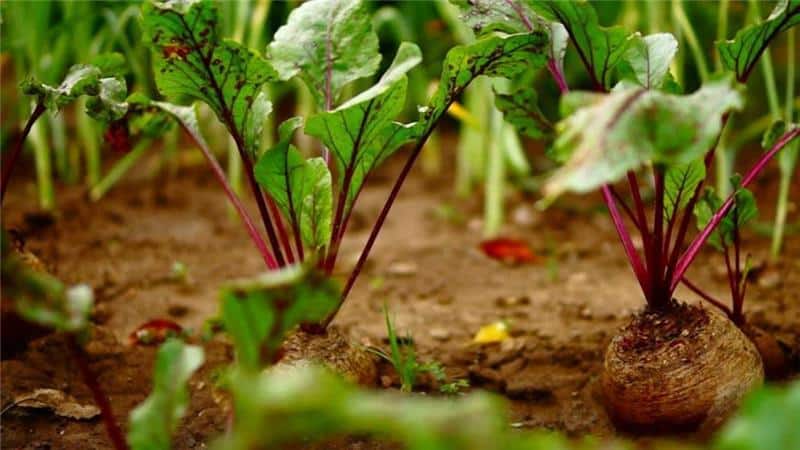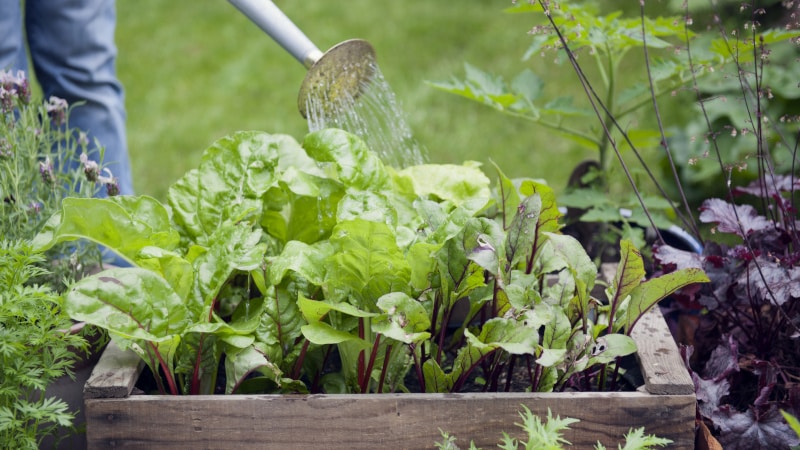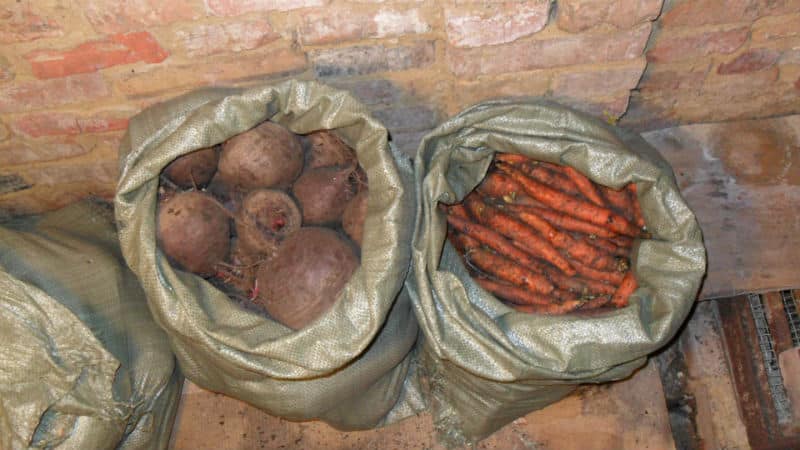Is it possible and necessary to hill beets: we understand the issue and study the general rules for growing root vegetables
People have been cultivating beets as a vegetable crop since before our era. For the first time, this healthy vegetable began to be grown on the islands of the Mediterranean Sea. In soils saturated with small crystals of sea salt, beets grew especially sugary and tasty. Over time, the root crop began to be cultivated in other countries, including Russia.
Beets are an unpretentious plant that does not require special care. In the article we will talk about the features of caring for the crop, as well as whether it is necessary to hill up beets if the upper part of the root crop sticks out of the ground.
Hilling up beets
After the sprouts appear, the beets begin to grow quickly, forming a lush rosette of leaves. Soon the root crop itself appears. The more it grows, the more it begins to protrude from the ground.
Is it necessary to hill up if the root crops are sticking out of the ground?
At this moment, the gardener often asks the question: is it necessary to hill up beets if they are sticking out of the ground? No no need. The fact that the root crop rises above the bed does not in the least prevent the beets from developing. On the contrary, the fruits grow and fill better this way. The sun's rays falling directly on root crops do not harm them at all.
Why is this not necessary?
The root system of the plant goes deep into the ground, providing growing root crops with all the necessary nutrients. There is no point in hilling, since beet tops do not produce lateral roots.
Beets love space, so they are often planted along the edge of beds occupied by other vegetables. At the same time, the root crops grow much larger than those planted in the traditional way in a separate beet bed.

Advice from experienced summer residents on growing beets
To grow a rich harvest of healthy vegetables, experienced gardeners advise adhering to the following rules:
- Thin out seedlings. Otherwise, the root crops will be crowded, and they will not grow large. Thinning begins when the sprouts stretch 5-10 cm. In this case, the plants are not pulled out, but cut off. Then the neighbor's root will remain intact.
- Monitor the condition of the beet tops. Yellowed and withered leaves indicate that there are not enough nutrients in the soil.
- Once or twice a season water beet plantings with salt water (1 tbsp per bucket of water). Surprisingly, salt will make root vegetables sweeter.
- Stop watering 3 weeks before harvest. Then the beets will gain more sugars and will be better stored in winter.
General algorithm for growing beets
Growing beets, like any other vegetable crop, begins with preparing the soil and selecting seed material.
Soil preparation and planting
It is better to plant beets where tomatoes, cucumbers, legumes or potatoes used to grow. It is not recommended to use those beds that previously contained other root crops.
In the selected area, the soil is dug up and fertilizers are applied. Remove weeds and level the ground.
Before planting, the seeds are soaked for 12 hours in a warm solution of boric acid (1.5 g per 1 liter of water). This will disinfect the seed material and enrich it with boron. After this, the seeds are removed and placed in plain water for another day.If the seeds are not prepared, you will have to wait a long time for germination (about 2 weeks). Soaked seeds germinate in 3-5 days.
Seeds are sown in heated soil, having previously moistened it well. Before mass shoots appear, make sure that the soil is constantly moist. It is effective to plant seeds before prolonged rains. On heavy soils, the planting depth is 2.5-3 cm. If the soil is light, then 3-4 cm.
In regions with short and cool summers, beets are grown through seedlings. Beetroot is picked at the cotyledon leaf stage. Plants are transplanted into open ground when a rosette of 2-3 true leaves appears. Young beet bushes tolerate transplantation well. Growing through seedlings speeds up harvest by about 3 weeks.
Watering and fertilizers

After the seedlings emerge or the seedlings are planted in a permanent place, the bed is watered often and little by little. Since young shoots are still weak and the root system is not developed, deep soil moisture is not required.
Need to know. During the period when root crops begin to form, beets experience the maximum need for moisture.
During the period of formation and intensive development of the root crop, water it abundantly - up to 20 liters per square meter. m. Poor daily irrigation is a mistake. This way, only the top layer of soil will be moistened, and the root crop will receive little water. Watering is stopped 2-3 weeks before harvesting. Then the root vegetables will be sweeter and tastier.
Advice. Water beet beds in the morning or evening. During the day, wet foliage can be burned by the sun.
Excess moisture also has a bad effect on plants, as does its lack.Overmoistening leads to a decrease in oxygen content in the soil, causes rotting of the root system and provokes the development of pathogenic microbes.
Yellowing of beet tops indicates a lack of nitrogen in the soil. It is this substance that is responsible for the formation of green root vegetables.
With nitrogen starvation, the leaves grow small and flaccid, and then change color. The first to turn yellow, thicken and coarse are the veins, and then the entire leaf.
Reddening of the foliage indicates a lack of magnesium. Spots on leaves and dying tips are a sign of iron deficiency.
The culture is sensitive to insufficient boron and manganese content in the soil. This problem is typical for sandy and calcareous soils.
The lack of nutrition is compensated for by root and foliar feeding. A quick effect is achieved by feeding with an infusion of mullein or chicken droppings (1 kg per bucket of water). Fertilizer is applied between rows (1 bucket per 10-15 linear meters). Any fertilizer that gets on the leaves is washed off with clean water.
Attention. All liquid fertilizing is carried out in July. During this period, the most active consumption of all nutrients occurs.
Thinning
Beet plantings require thinning. Thin out the seedlings in two stages. The first time is when the seedlings reach 3-5 cm in height. From a group of plants, the strongest is selected, the rest are removed. A gap of 4-5 cm is left between adjacent bushes.
The beets are thinned out the second time when the plants have grown to 10 cm. This time a distance of 10-12 cm is left between them.
Weeding and loosening
The next day after watering or rain, the soil is loosened. At the same time, weeds are removed. Loosening should not be neglected, especially if the soil is heavy.For full growth, root crops need constant access to oxygen.
Mulching a beet bed can significantly facilitate care and reduce the amount of weeding and loosening. Straw, peat, and humus are used as mulch.
Disease and pest control
Beetroot suffers from diseases such as downy mildew, brown rot, cercospora blight, and blackleg. Let's take a closer look at them.
Downy mildew
A fungal disease transmitted through contaminated plant debris. Infection is indicated by deformation of the tops, the appearance of plaque, yellowing and wilting of leaves. Methods of control: soil disinfection, the drug “Baikal EM-1”.
Brown rot
A disease that affects root crops. In diseased plants, the tops are underdeveloped. The leaves gradually turn yellow and die. The fruits themselves begin to rot during long-term storage.
Black leg (root beetle)
This is rotting of the stem, leading to the death of the plant. The development of the disease is provoked by excess moisture and acidic soil. Prevention - proper agricultural technology, moderate watering.
Cercospora
A fungal disease that appears as light spots with a brown border on the leaves.
Beet plantings are also affected by insect pests. They pose the greatest danger to immature young plants.
Insects that can cause serious damage to beet crops are listed below.
Beet aphid
A wingless black insect. The larvae are light. Lays black, shiny eggs. The parasite is dangerous because it sucks the juice from the beet tops. Infected foliage becomes deformed and curls. The leaves turn yellow, the edges and tops curl down, wither and dry out. The growth of root crops slows down, vegetables grow small and unsightly.To combat, drugs and folk remedies are used - for example, a soap solution.
Common beet flea beetle
The beetle is bronze-metallic in color. Activates in April – May. It feeds mainly on young beet shoots. Eggs are laid in the soil in late spring. After hatching, the larvae eat plant roots. Flea fleas are recognized by small holes on the leaves and petioles. If there are a lot of pests, the leaves become like lace.
Beet beetleaf
A flat beetle, green or brown, 6-7 mm in length. Overwinters under plant debris and fallen leaves, as well as in weed thickets. The greatest damage is caused by the larvae of the shield moth, which completely eat up the leaves.
Beet leaf miner
The pest is gray-brown in color, 6-7 mm in length. Fly larvae are pale yellow with a wrinkled body surface. They gnaw through the leaf and penetrate inside, forming cavities (mines) inside. From the outside, the damaged area looks like a bubble. Affected leaves turn yellow and dry out. Damage to beets is especially dangerous at the initial stage of growth.
Beet weevil
The beetle is gray-brown in color. The pest is capable of destroying plantings over large areas. The weevil lays eggs in the soil. The larvae emerge after 11 days and gnaw beet roots in the soil. Because of this, root crops grow in irregular shapes.
Pest control measures:
- compliance with agricultural technology;
- loosening the soil;
- spraying with neonicotinoids, pyrethroids and other insecticides;
- feeding with ammonia water.
Harvesting and storage

Beets are removed from the garden earlier than carrots. Beetroots protrude more above the soil surface and are therefore more damaged frosts. Yellowed and dried lower beet leaves indicate that the vegetable is ripe.
Root vegetables are dug up carefully so as not to damage the skin. Then the root crops are cleaned of soil residues. After this, the tops are cut off using a sharp knife; the petioles are no more than 2 cm. When harvesting, the root crops are protected from mechanical damage.
The harvested root crops are carefully sorted before storage to prevent the possible spread of diseases.
Root crops without mechanical damage and not affected by diseases are well stored for up to 8 months. Fruits whose diameter does not exceed 10 cm are best stored. The optimal temperature in the vegetable store is 2-3 ° C, humidity – 80%.
There are many options for storing beets. Root vegetables fit well in ordinary plastic bags, sprinkled with sawdust or sand. You can store vegetables in sand, peat, shavings or sawdust in dry and clean boxes. The best place for storage is underground, cellar or basement.
Conclusion
Beetroot is an unpretentious garden crop that does not require hilling. With the cultivation of root crops Even a novice gardener can handle it. An indicator of plant health is young beet tops. It should be bright green, without spots or signs of disease.
This plant does not require hilling, since the beet roots go deep underground and provide the crop with the necessary amount of nutrients. The plant only needs timely and moderate watering, as well as fertilizing if necessary.